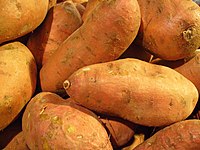
Photo from wikipedia
ABSTRACT The mechanisms of low cadmium (Cd) accumulation in sweet potato cultivars are obscure. In this study, seedlings of a low-Cd (Nan88, N88) and a high-Cd cultivar (Xiang 16, X16)… Click to show full abstract
ABSTRACT The mechanisms of low cadmium (Cd) accumulation in sweet potato cultivars are obscure. In this study, seedlings of a low-Cd (Nan88, N88) and a high-Cd cultivar (Xiang 16, X16) were grown in Hoagland’s solution containing Cd concentrations of 0 (control), 1 (Cd1), and 10 µM (Cd10) for 20 days. We analyzed the Cd accumulation, root morphology and low molecular weight organic acids (LMWOAs) excreted by the root tips (RTs). The total root length (RL) and specific root length (SRL) in X16 were greater than those in N88 following Cd treatments. In the Cd1 treatment, RL and surface area for root diameter was ≤0.2 mm, and RTs in X16 were also greater than those in N88. LMWOAs excreted from the RTs initially increased and then decreased as Cd concentration increased. The RTs of N88 were more efficient at excreting organic acids than were those of X16. The low-Cd cultivar with lower RL and SRL displayed greater ability to excrete organic acids in Cd treatments, which can decrease Cd translocation from roots to shoots. Furthermore, root morphology and some LMWOAs released from the root tips played an important role in the differing rates of Cd accumulation in the two sweet potato cultivars.
Journal Title: Archives of Agronomy and Soil Science
Year Published: 2017
Link to full text (if available)
Share on Social Media: Sign Up to like & get
recommendations!